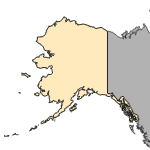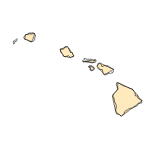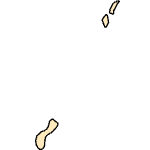Barbonymus schwanenfeldii
(tinfoil barb)
Fishes
Exotic |
|
Common name: tinfoil barb
Synonyms and Other Names: Goldfoil barb, Schwanefeld's barb. Other modifications of name used include Barbodes schwanefeldi, Barbus schwanenfeldii, Barbus schwanefeldi, Puntius schwanenfeldi, and P. schwanefeldii.
Taxonomy: available through
www.itis.gov
Identification: Distinguishing characteristics were given by Roberts (1989) and by Kottelat et al. (1993, as Barbodes schwanenfeldii). It is included in the keys of Smith (1945) and Kottelat (1985). Color photographs appeared in Axelrod et al. (1985) and in Kottelat et al. (1993).
Size: 35 cm SL (Baird et al. 1999)
Native Range: Tropical Asia. Thailand, Malaysia, Sumatra, and Borneo (Roberts 1989), also Kampuchea, Laos, and Vietnam (Kottelat 1985). Laos (Baird et al. 1999).



|

Alaska |

Hawaii |

Puerto Rico &
Virgin Islands |

Guam Saipan |
Hydrologic Unit Codes (HUCs) Explained
Interactive maps: Point Distribution Maps
Nonindigenous Occurrences:
Table 1. States with nonindigenous occurrences, the earliest and latest observations in each state, and the tally and names of HUCs with observations†. Names and dates are hyperlinked to their relevant specimen records. The list of references for all nonindigenous occurrences of Barbonymus schwanenfeldii are found here.
Table last updated 11/28/2024
† Populations may not be currently present.
Means of Introduction: Probable escape from fish farm in Florida; aquarium release in Indiana.
Status: Failed in Florida and Indiana.
Impact of Introduction: The impacts of this species are currently unknown, as no studies have been done to determine how it has affected ecosystems in the invaded range. The absence of data does not equate to lack of effects. It does, however, mean that research is required to evaluate effects before conclusions can be made.
References: (click for full references)
Axelrod, H.R., W.E. Burgess, N. Pronek, and J.G. Walls. 1985. Dr. Axelrod's atlas of freshwater aquarium fishes. Tropical Fish Hobbyists Publications, Inc, Neptune City, NJ. 780 p.
Baird, I.G., V. Inthaphaisy, P. Kisouvannalath, B. Phylayanh and B. Mounsouphom. 1999. The fishes of southern Lao. Lao Community Fisheries and Dolphin Protection Project. Ministry of Agriculture and Forestry, Lao PDR. 161 p.
Courtenay, W.R., Jr. and C.R. Robins. 1973. Exotic aquatic organisms in Florida with emphasis on fishes: a review and recommendations. Transactions of the American Fisheries Society 102(1):1-12.
Courtenay, W.R., Jr., H.F. Sahlman, W.W. Miley II, and D.J. Herrema. 1974. Exotic fishes in fresh and brackish waters of Florida. Biological Conservation 6(4):292-302.
Courtenay, W.R., Jr. and D.A. Hensley. 1979a. Range expansion in southern Florida of the introduced spotted tilapia, with comments on its environmental impress. Environmental Conservation 6(1):149-151.
Courtenay, W.R. and D.A. Hensley. 1979b. Survey of introduced non-native fishes. Phase I. Introduced exotic fishes in North America: Status 1979. Report submitted to National Fisheries Research Laboratory, US Fish and Wildlife Service, Gainesville.
Kottelat, M. 1985. Freshwater fishes of Kampuchea. Hydrobiologia 121:249-279.
Kottelat, M., A.J. Whitten, S.N. Kartikasari, and S. Wirjoatmodjo. 1993. Freshwater fishes of western Indonesia and Sulawesi. Periplus Editions, Ltd, Republic of Indonesia. 221 p.
Roberts, T.R. 1989. The freshwater fishes of Western Borneo (Kalimantan Barat, Indonesia). Memoirs of the California Academy of Sciences 14:210 p.
Seng, P. and G. White. 2003. Indiana aquatic nuisance species (ANS) management plan. Indiana Dept of Natural Resources. http://www.in.gov/dnr/4627.htm
Smith, H.M. 1945. The fresh-water fishes of Siam, or Thailand. Bulletin U.S. National Museum (Smithsonian Institution) 188:1-622.
Other Resources:
FishBase Summary
Author:
Leo Nico, Bill Loftus, and Matt Neilson
Revision Date: 10/29/2012
Peer Review Date: 10/29/2012
Citation Information:
Leo Nico, Bill Loftus, and Matt Neilson, 2024, Barbonymus schwanenfeldii (Bleeker, 1853): U.S. Geological Survey, Nonindigenous Aquatic Species Database, Gainesville, FL, https://nas.er.usgs.gov/Queries/FactSheet.aspx?SpeciesID=633, Revision Date: 10/29/2012, Peer Review Date: 10/29/2012, Access Date: 11/28/2024
This information is preliminary or provisional and is subject to revision. It is being provided to meet the need for timely best science. The information has not received final approval by the U.S. Geological Survey (USGS) and is provided on the condition that neither the USGS nor the U.S. Government shall be held liable for any damages resulting from the authorized or unauthorized use of the information.